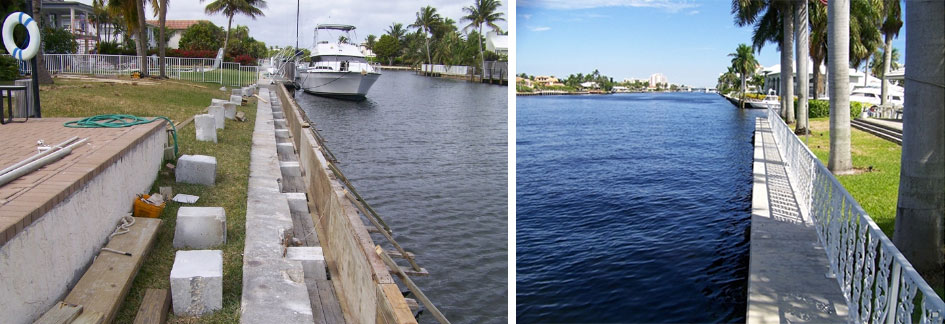You know about boats. Yours is 25’ long, 320 horsepower, a max draft of 34” with the drive down…not to mention the handy 25 quart cooler. You know that you need a dock where you can keep your boat. You need a boat lift on that dock. You’re willing to spend upwards of $100,000, if not more, to build all of this onto your property to house your precious vessel.
But do you know anything about seawalls, the anchor for your dock and the last line of defense for your property against tides? If you ignore the seawall, you may be putting the water skier in front of the motorboat.
Joe Harper, the owner and founder of South Florida Dock & Seawall in Fort Lauderdale, knows that a quality seawall is essential, regardless of whether you own a boat or not.
“If you see what happened in Pompano and Garden Isles, where in December we had like 15 inches of rain, and five seawalls fell in this neighborhood and the whole neighborhood is freaking out because they’re scared to death that their walls are going to fall in,” he says, reflecting on a wet end to 2015. “The walls fall in and they lose everything up to the pool shell. Very scary, costly thing when you wake up in the morning and your seawall is laying at the bottom of the canal and your yard’s gone.”
The longtime marine construction expert only sees the importance of solid seawalls rising as the prospect of higher tides rise as well.
The best way to ensure that you don’t end up with a rickety wall holding up your property and dock? Make sure you buy a property that’s well-supported to begin with. Harper notes that some selling waterfront property may take the chance that a potential buyer doesn’t know anything about seawalls, rather than taking steps to repair them before a sale. Conventional home inspectors aren’t expected to make qualified examinations, either. Therefore the onus for a seawall review falls upon the buyer.
The best bet is for the prospective buyer to hire a professional to do a formal inspection of the seawall in question. After all, much of the structure is underwater, and people with both engineering expertise and SCUBA certification are rare.
That said, there are a few steps you can take to get an idea if a seawall might cause problems before you bring in a qualified inspector. Here are some noticeable above-water symptoms and what they could mean for the seawall in question.
Sinkholes behind The Wall, Visible Soil Contamination in Water, Rust
These are all signs of slab-joint separation. Seawalls are built of tall, interlocked concrete panels, or slabs. If the joints between two panels become separated, it becomes evident when backfill soil from behind the wall begins to flow into the waterway. This is most evident when sinkholes form behind the wall on the property, indicating where the soil is eroding through the separated slabs. Evidence of soil pollution is also obvious in the form of murkier water than usual. More often than not, these cracks and separations can be seen from the water as well. The red color of rust on a cap (the concrete box structure that connects the seawall at the top) can also be an indication that separation is taking place.

Deteriorating Cap, Saggy Panels
One of the most obvious signs that erosion is taking its toll on a seawall is when the structure is leaning out into the waterway, rather than standing straight up. The corrosive nature of saltwater can cause this in two different ways. One, the cap that holds the panels upright may have deteriorated to the point where it can no longer maintain the wall. Or, the tie-back rods that anchor the wall to a concrete block underground, may have corroded, allowing the wall to fall forward under the weight of the soil.
Cap Rotation, Wall Tilting toward Land
In other situations, the wall may tilt in toward the land and not out toward the waterway. This indicates that something may be wrong at the toe, or bottom of the wall. If the berm that supports the bottom of the wall (as the cap supports the top) gives way, the bottom of the wall will slide outward, causing the top to lean in. The soil of the property threatens to push outward as well, undermining the land above it.
Horizontal Cracks
Vertical cracks probably indicate slab-joint separation, but horizontal cracks suggest that waterline damage is taking place. Corrosion from constant tides on aging concrete and uneven hydrostatic pressure can cause these cracks, which are liable to give way and spill the land into the waterway.
If you end up buying a piece of waterfront property, even with a perfect seawall in place, make sure to maintain upkeep and have it inspected at least every few years to make sure it stays in optimal condition. Nonetheless, be prepared to find some homes with questionable seawalls when house-shopping. Harper has been working in marine construction in Fort Lauderdale for more than 30 years…and he reports that some of the seawalls have been around twice as long as that. Repairs, and sometimes replacements, are essential.

